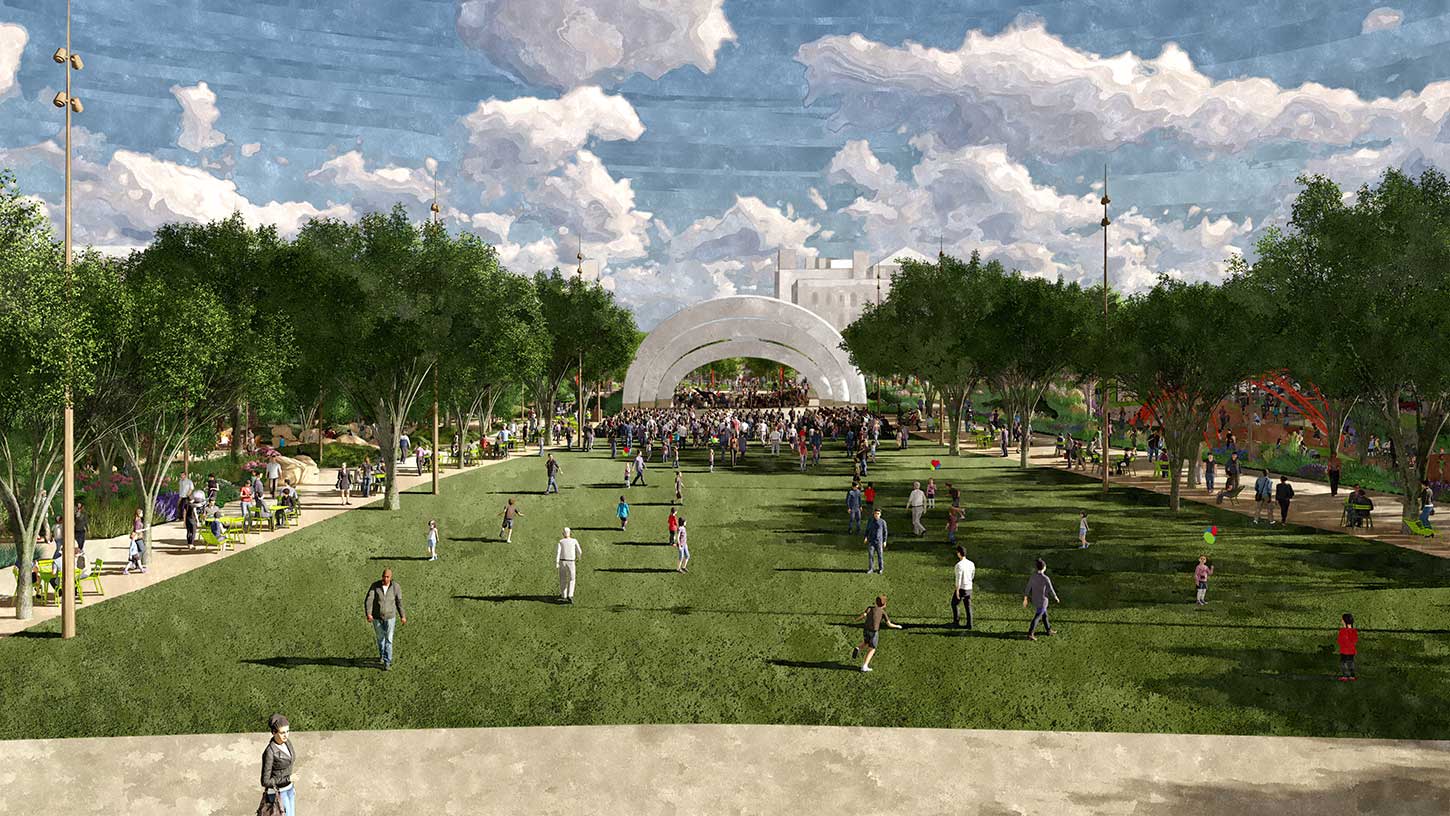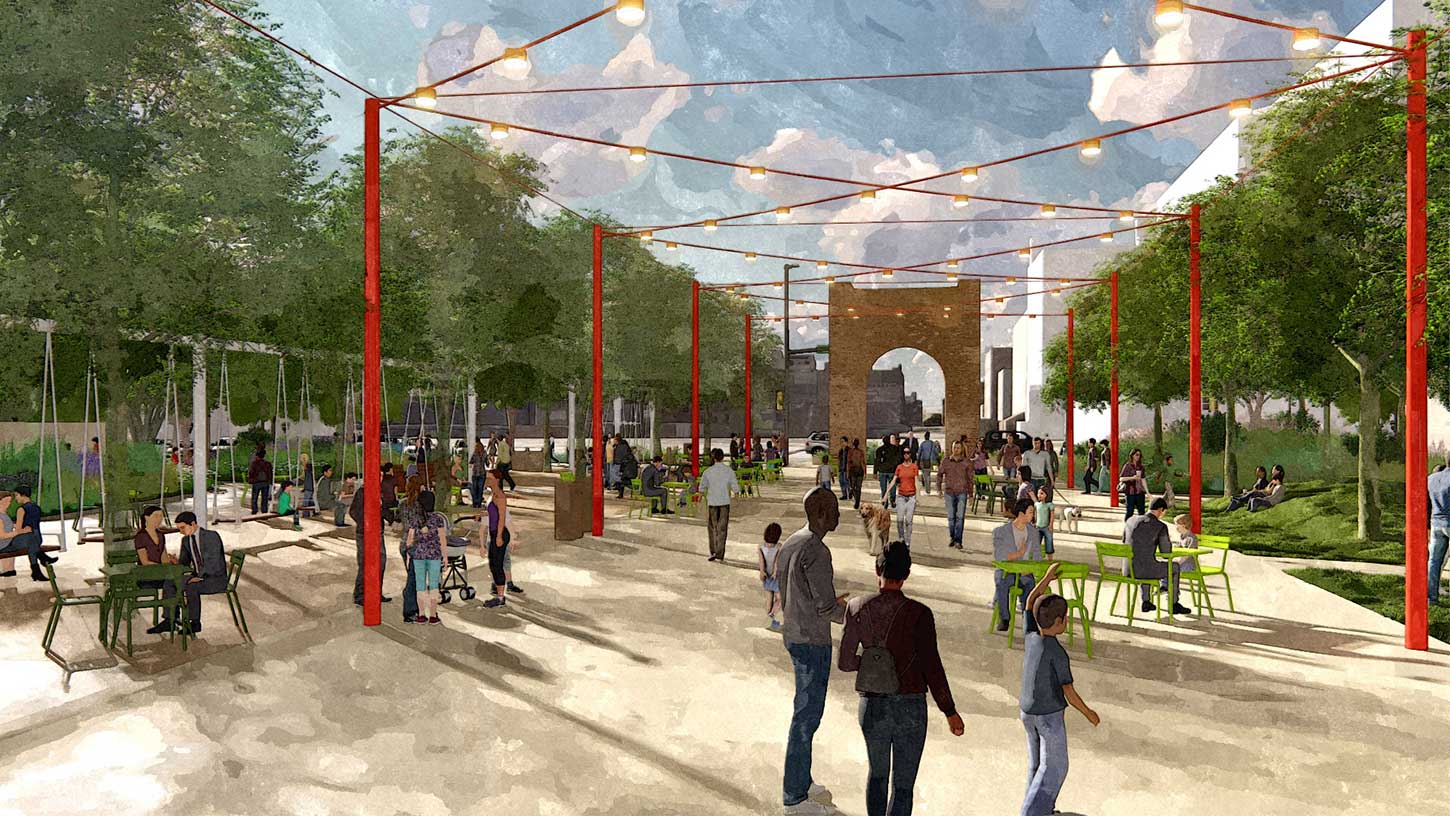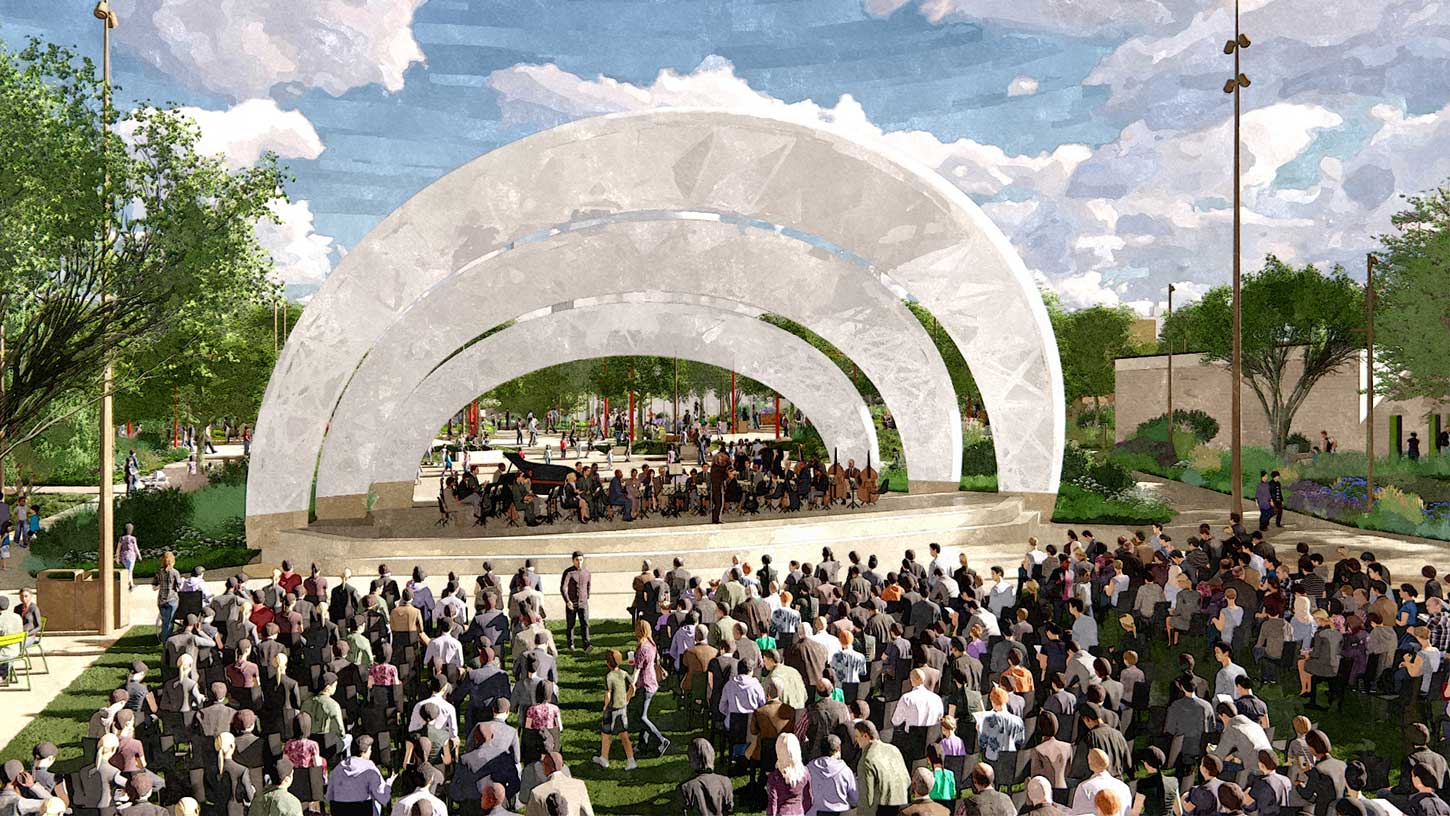By Jay Landers
As part of an ongoing $325 million project, the city of Omaha, Nebraska, is revamping three key parks to increase their appeal to residents and visitors alike. The RiverFront Revitalization Project involves more than 70 acres of urban parkland near and adjacent to the Missouri River and aims to improve connections between the city and the river, foster economic growth, and add a wide variety of recreational features and other improvements to attract more visitors.
After three years of construction, the first of the three reconfigured parks is scheduled to open in late May. Design challenges on the project have included complexities associated with construction in an urban environment, including having to account for past industrial contamination.
Unclear connections
The three parks that are the focus of the RiverFront Revitalization Project are situated close together. Located on the eastern edge of downtown Omaha is a 14.5-acre park known as the Gene Leahy Mall, which will be the first park completed. The width of a city block, this park extends from 14th Street to the west to Eighth Street on the east. The eastern end of Gene Leahy Mall abuts the 21.8-acre Heartland of America Park, which is situated on the western bank of the Missouri River. Immediately to the north of Heartland of America Park is the 25-acre Lewis and Clark Landing, which also extends along the river.
Despite the proximity of the three areas to each other, “most people did not realize the parks were connected,” says Christopher Koenig, P.E., a senior project manager for HDR, the lead design firm on the project. Pedestrian access between the areas was limited to street sidewalks and two pedestrian bridges, one of which extended over Eighth Street to link Gene Leahy Mall to Heartland of America Park. The other extended over railroad tracks to connect Heartland of America Park to Lewis and Clark Landing.
Unfulfilled potential
Although they have been in place for decades, the three parks have failed to live up to their potential for differing reasons. Originally constructed in the 1970s, Gene Leahy Mall comprised a “lagoon with elevation set well below the street grade with walking trails and a few bridges,” Koenig says. “The concept was to provide a restful setting for people to take a break” from nearby office buildings, he says, though it did not provide gathering areas. Also, “unfortunately, the park experienced minimal use, especially at night, due to the perception of safety,” Koenig notes.
The second park, the Heartland of America Park, was developed in the 1980s on a remediated industrial site and included a lake with walking trails, an iconic fountain, a small amphitheater area, and a boat dock for boat rides. Although a flood wall that conveyed railroad tracks separated the main park area from the river, an overlook was constructed over the flood wall and tracks “to provide a lookout over the river,” Koenig says. While the Heartland of America Park also included the area riverward of the flood wall, this area was “overgrown and not accessible or welcoming,” Koenig says.
Despite its scenic location, Heartland of America Park also suffered from certain drawbacks. For starters, access to the park was “limited and difficult,” Koenig says. “The park did not have any level areas and was not conducive to events,” he says. “Like Gene Leahy Mall, the park saw minimal usage, especially at night due to safety concerns,” he notes.
The third park, Lewis and Clark Landing, is located on a former lead smelting facility site. This park was developed in the late 1990s and early 2000s; buildings associated with the smelting facility were razed and buried on-site and the site was capped. The park consisted of parking lots and an event plaza riverward of the flood wall as well as memorials and recreational trails.
“Unfortunately, the site did not include any trees” and it offered a “minimal number of shade structures,” Koenig says. “The park was used for events but saw very limited usage during nonevent times.”
Filling in the lagoon
Planning and design for the revitalization began in fall 2017. Five key goals have driven this effort, Koenig says. These goals are to:
- Connect the parks to the river.
- Create a variety of active spaces.
- Create an implementable, sustainable, and maintainable plan.
- Be a catalyst for growth.
- Become a regional destination.
OJB served as the lead firm for the planning and design of the site amenities.
For Gene Leahy Mall, fulfilling the various goals meant draining and filling in the on-site lagoon to raise it to street level. Grade-control structures were demolished, and the pump stations that had been used to recirculate water throughout the lagoon were removed.

“The lagoon bottom was stabilized with geotextile fabric and crushed rock prior to placement of the embankment material,” Koenig says. Filling the lagoon required approximately 97,000 cu yd of material having a maximum fill depth of 22 ft. The project will add 40,000 sq ft of lawn space in downtown Omaha.
The project also entailed the removal of the 14th Street bridge that spanned the park. To improve park access, the bridge was “reconstructed as an at-grade street with on-street parking, a drop-off area, and a bike lane,” Koenig says. Whereas the original park eliminated access at 11th Street, the new park includes a pedestrian promenade in this location “to allow easy pedestrian access through the park between the adjacent entertainment districts,” he says.

As for other improvements, the upgraded Gene Leahy Mall will include a performance pavilion and large lawn to be used for concerts and events. Additional attractions include a large playground, restrooms, a water play feature, a sculpture garden, a pond and boat cove for model boats, dog parks, canopy shade structures, benches, and sitting areas.
Gene Leahy Mall also will feature a “large number of trees and plantings with bioswales woven into the design of the park,” Koenig says.
The presence of two historic buildings in this park complicated construction. “Both buildings are brick construction with one having a stone foundation,” Koenig says. Demolition efforts had to be conducted near the buildings, as did the removal of structural elements and pavement.
“Monitors were installed in the buildings that measured the amount of vibration caused by the equipment and the demolition operations,” Koenig says. “The acceptable levels of vibration were established, and the contractor was required to modify their operations if the established vibration levels were exceeded.” The Kiewit Infrastructure Group is the general contractor for the project.

Past contamination and a critical utility
At Heartland of America Park, ongoing construction has involved filling in the northern third of the existing lake and raising the area to street grade. “A total of 265,000 cu yd of fill was brought in, of which 120,000 cu yd was surcharge,” Koenig says. The maximum fill depth was 34 ft.
An existing street was “extended through the park with a new at-grade crossing” over the railroad tracks “to improve accessibility and connectivity for the park,” Koenig says.
Future amenities to be added to the park include a large lawn for concerts, a skating ribbon that can be used for ice skating in winter and rollerblading in summer, a promenade that will connect to a new overlook over the railroad tracks and flood wall, an amphitheater, restrooms, a picnic area, playground, walking trails, and a boat dock and ramp. The park also will feature a “recreational trail that will eventually allow continuous connection throughout the downtown area,” Koenig says.
The design team had to account for past contamination still present at the park site, which previously had been occupied by several industries. Depending on its metal content, some of the waste from these activities had been stabilized in place with concrete, while some had simply been buried. A 3 ft thick soil cap had been placed over the material.
“The proposed improvements necessitated removal of a portion of the material,” Koenig says. However, the “limits and locations of the waste material” had not been well documented, he notes. “Exploratory trenches were dug to identify the waste limits,” he says. Based on these findings, the design was “adjusted accordingly to avoid the material to the extent possible.”
Great pains were taken to ensure that embankment construction did not damage an adjacent, critical 161 kV electrical line to the east of Heartland of America Park.
The buried line consists of cable located in two steel pipes encased in concrete. “Failure of the line would result in a significant power outage” in downtown Omaha, Koenig says. The electrical service provider “required zero movement” of the line, Koenig says. However, movement of the line was calculated to be possible with the proposed embankment construction, he notes.
To ensure that no such movement occurred, the contractor installed monuments “on top of the concrete encasement with an automated survey system to continually survey the monuments and provide the data for review,” Koenig says. “Inclinometers were installed within the park to be used as an early warning system. The contractor was required to stop embankment operations if any movement was noted.”
Opening in 2023
Improvements to Lewis and Clark Landing will include reconstruction of a road that will link the park more directly to Heartland of America Park. Other amenities will include a playground, restrooms, an urban beach, sand volleyball courts, and pickleball courts.
The design for the site also had to account for past industrial contamination, which had been buried on-site beneath a geosynthetic clay layer, a drainage layer, and a minimum of 6 ft of embankment. “The original covenants for the remediated site did not allow for trees,” and buildings could only have shallow footings, Koenig says. “The proposed improvements were designed to limit the impact to the geosynthetic clay layer and existing footings, including the use of spread footings.” Only trees whose roots would not penetrate the clay layer were selected for the project.
Heartland of America Park and Lewis and Clark Landing are scheduled to open in summer 2023. All three parks will be operated and maintained by the Metropolitan Entertainment & Convention Authority, a private nonprofit organization that has worked with the city of Omaha to develop the facilities.
Although none of the parks are being expanded in terms of their size, the alterations to their surface levels will allow for a much greater range of activities than had been possible before, says Katie Bassett, the vice president of parks for MECA. “We’ve brought a lot of the park space up to grade,” she says. As a result, there is more park space for “people to get in and enjoy.”



